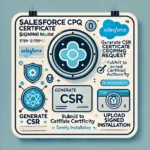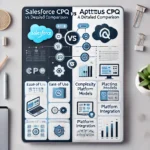Journey Data vs Contact Data in Salesforce-Salesforce, a leading Customer Relationship Management (CRM) platform, utilizes various types of data to enhance customer interactions and business insights. Two critical types of data within Salesforce are journey data and contact data. Understanding their differences, uses, and implications can significantly impact how organizations manage and optimize customer relationships and marketing efforts.
What is Contact Data?
Contact data in Salesforce refers to the foundational information about individual customers or prospects. It includes details such as:
- Name: The name of the contact.
- Email Address: Contact’s email address for communication.
- Phone Number: Contact’s phone number for direct outreach.
- Company: The organization or company the contact belongs to.
- Job Title: The position or role of the contact within the company.
- Address: Physical location details, including city, state, and country.
Contact data serves as the core information used to identify, communicate with, and track individual contacts within the Salesforce CRM system. It forms the basis for building relationships, executing sales processes, and providing personalized customer service.
What is Journey Data?
Journey data in Salesforce refers to the collection of interactions and activities that a contact or customer engages in throughout their lifecycle with a brand. It includes:
- Interactions: Any touchpoints or engagements such as website visits, email opens, form submissions, and social media interactions.
- Behaviors: Actions taken by the contact, such as purchases, content downloads, event attendance, and webinar participation.
- Campaign Responses: Responses to marketing campaigns, including clicks, conversions, and responses to targeted communications.
- Service Interactions: Support requests, tickets raised, and resolutions provided through customer service channels.
Journey data provides a holistic view of how contacts interact with a brand across multiple channels and over time. It enables organizations to track the effectiveness of marketing campaigns, understand customer preferences, and personalize interactions based on historical behaviors and engagements.
Key Differences Between Journey Data and Contact Data
Nature of Data:
- Contact Data: Static information about individuals or organizations, typically entered manually or captured during initial interactions.
- Journey Data: Dynamic and evolving information that captures ongoing interactions, behaviors, and engagements over time.
Usage:
- Contact Data: Used for identifying and categorizing contacts, segmenting audiences, and personalizing communications based on demographic and firmographic details.
- Journey Data: Used for analyzing customer behavior, optimizing marketing strategies, measuring campaign effectiveness, and improving customer experiences based on historical interactions.
Context:
- Contact Data: Provides basic details necessary for initial contact and ongoing relationship management.
- Journey Data: Provides context-rich insights into customer preferences, interests, and engagement patterns throughout the customer lifecycle.
Integration:
- Contact Data: Integrated into CRM processes for sales, marketing, and customer service activities.
- Journey Data: Integrated with marketing automation platforms, analytics tools, and customer journey mapping tools to drive targeted campaigns and personalized experiences.
Uses of Contact Data vs Journey Data in Salesforce
Uses of Contact Data:
- Lead Management: Capture and qualify leads based on demographic and firmographic criteria.
- Account Management: Manage relationships with organizations and track key stakeholders within accounts.
- Sales Processes: Track opportunities, pipeline stages, and sales activities associated with individual contacts.
- Customer Support: Provide personalized support and resolutions based on contact details and history.
Uses of Journey Data:
- Marketing Automation: Automate personalized communications and nurture campaigns based on behavioral triggers and engagement patterns.
- Campaign Optimization: Measure the effectiveness of marketing campaigns, adjust strategies in real-time, and optimize budget allocation.
- Customer Experience Enhancement: Identify pain points in the customer journey, improve touchpoints, and deliver seamless omnichannel experiences.
- Sales Enablement: Equip sales teams with insights into prospect engagement history and preferences to tailor conversations and offerings.
Comparison Table: Contact Data vs Journey Data
| Feature/Capability | Contact Data | Journey Data |
|---|---|---|
| Type of Information | Static, demographic, firmographic details | Dynamic, behavioral, interaction history |
| Usage | Identify, categorize contacts | Analyze behavior, optimize campaigns |
| Integration | CRM systems, contact databases | Marketing automation, analytics platforms |
| Analysis | Segmentation, personalization | Campaign effectiveness, customer insights |
| Tools | Salesforce CRM, data entry forms | Marketing Cloud, Analytics Cloud |
External Links
FAQs
What is the primary purpose of contact data in Salesforce?
Contact data is used to identify, categorize, and manage individual contacts or organizations within Salesforce. It serves as the foundational information for initiating and maintaining relationships with customers and prospects.
How does journey data differ from campaign data?
Journey data encompasses a broader scope of interactions and behaviors over time, including all touchpoints and engagements beyond specific campaign responses. Campaign data focuses on responses to targeted marketing initiatives within defined periods.
Can journey data be used for predictive analytics?
Yes, journey data provides historical insights into customer behaviors and patterns, which can be analyzed to predict future actions, preferences, and potential churn risks. This helps organizations proactively optimize marketing strategies and customer experiences.
How can businesses leverage both contact data and journey data for personalized marketing?
By integrating contact data with journey data, businesses can create highly personalized marketing campaigns. They can segment audiences based on demographic details and past interactions, then automate targeted communications and promotions based on observed behaviors and preferences.
What are some best practices for managing journey data in Salesforce?
Best practices include regularly updating and consolidating data sources, integrating with CRM and analytics platforms for comprehensive insights, defining clear data governance policies, and leveraging AI and machine learning for predictive analytics and automated decision-making.
Conclusion
Understanding the differences between journey data and contact data in Salesforce is crucial for leveraging these insights to enhance customer engagement, optimize marketing strategies, and drive business growth. While contact data provides foundational details for identifying and categorizing contacts, journey data offers dynamic insights into customer behaviors and interactions across the entire customer lifecycle.
By effectively managing and integrating both types of data within Salesforce, organizations can create personalized customer experiences, improve campaign effectiveness, and foster long-term customer loyalty in today’s competitive marketplace.


